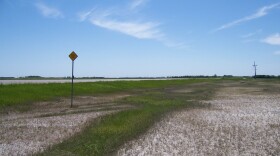If you spend time around marshes during the summer months, you are likely to become familiar with the yellow-headed blackbird. The name of this bird is quite descriptive, but it is occasionally referred to (with tongue firmly in cheek) as a “black-bodied yellow bird.”
Yellow-headed blackbirds are a species closely associated with prairie wetlands where they nest in wetlands that are deep enough to support bulrushes or cattails. They may be observed across the state, but more so in the prairie potholes north and east of the Missouri River. Their diet largely consists of insects, grain, and a variety of seeds. As a result, in addition to being observed in wetlands, they are also observed in grain fields, farmyards, and other places where spilled grain and weed seeds are available.
Like the more abundant red-wing blackbirds, yellow-headed blackbirds nest amongst wetland vegetation. Both species are territorial, and one would expect some competition for nesting sites. But the competition is reduced in that the yellow-headed blackbirds prefer to nest amongst bulrushes or cattails in a little deeper water than what red-wing blackbirds prefer.
Yellow-headed blackbirds are polygamous, with a male accumulating a harem of a dozen or so females that will nest within his territory. Nests are constructed of vegetation weaved around the stems of cattails, bulrushes, or other emergent vegetation. If all goes well, each female will produce one brood from 2-5 eggs.
Descriptions of the vocalizations of the yellow-headed blackbird are often rather disparaging, referred to as a call, not a song. Charles Flugum wrote an interesting description of the call of the yellow-headed blackbird in his Birding from a Tractor Seat (1975). He noted that it “begins with a few harsh, distinct notes, then becomes jumbled with hoarse croaks and ends with a prolonged, low, rasping sound, which some say resembles the squeaking of rusty hinges…it is produced with a great deal of effort and fluffing of feathers, similar to that of a young rooster just learning to crow.”





